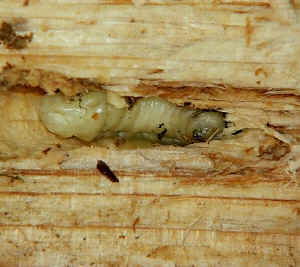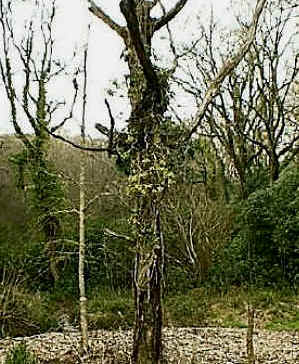 |
The pursuit of tidiness when
managing natural habitats is usually the opposite of conservation. Removing dead and dying
trees, tidying up piles of dead leaves or clearing scrub, bramble and rotting wood removes
vital microhabitats for countless organisms. It has been estimated that if dead and dying trees and decaying logs are removed from a woodland, up to 20% of the fauna of the woodland may be lost. The rotting wood fauna includes an enormous variety and number of beetles, ranging from stag beetles to bark beetles. Many of these live in the rotting wood as larvae (left), emerging from this microhabitat once mature. |
| . | |
 |
Rotting wood microhabitats
are incredibly diverse. The inhabitants of dead standing trees will often be different to
those in fallen rotting trees and this may again be different to that of log piles. As
great a variety as possible of rotting wood microhabitats should therefore be encouraged
within a woodland. Standing dead wood should be left unless unsafe. This provides habitat for the fungi and invertebrates which prefer this type of rotting wood. These will in their turn provide food for birds such as woodpeckers. The holes left by their searching beaks are often evident in standing rotten tree trunks. The rotting trunks also provide ideal nest holes for woodpeckers, as well as bats. Fallen timber should be left to decay naturally where it lies. Leaving stacks of logs in a variety of conditions, from heavily shaded to wet will also encourage biodiversity. |
| . | |
 |
Brambles and scrub may have to be controlled to maintain access on paths and rides, as well as to promote a diversity of plant species. However, they should not be removed in the interests of tidiness. All native plant species will be important sources of food or shelter for some invertebrates. The shelter of thick bramble clumps will also provide safe nesting and breeding sites for birds and mammals, while the fruits are important seasonal sources of food. |